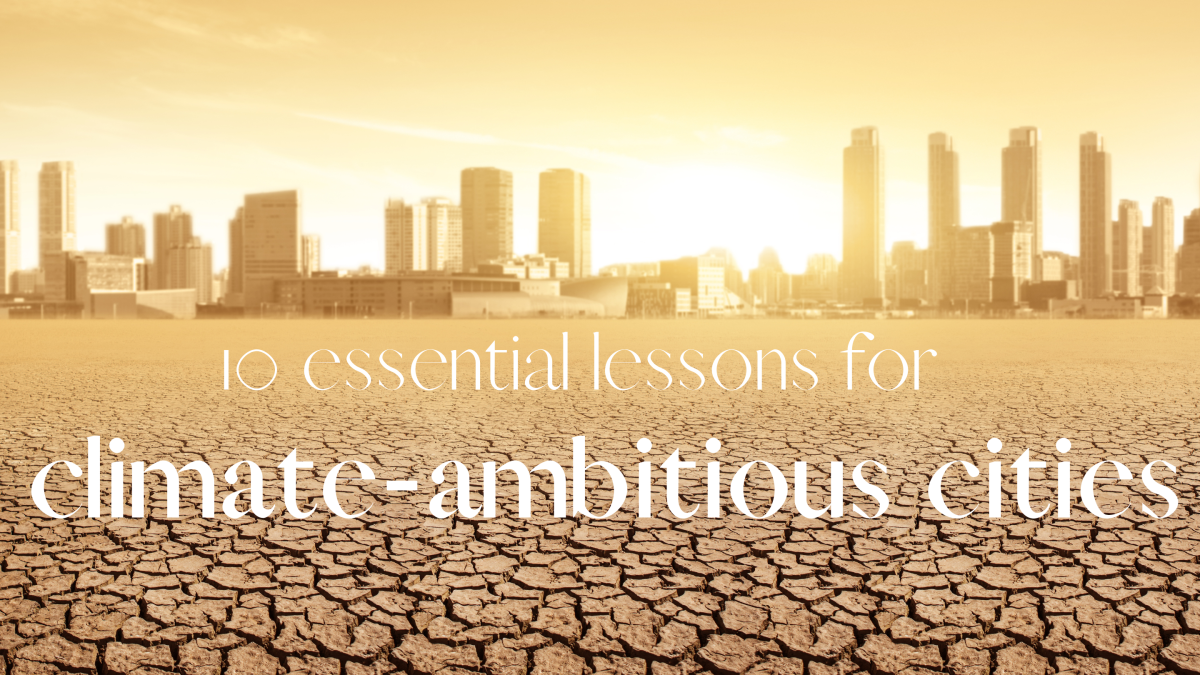A critical question in the wake of COP 27 is how to speed up implementation of climate policies.
The complexity of the challenge requires design and employment of a mix of collaborative, regulative, and financial policy tools to pursue effective climate transformation. Such a hybrid form of governance enables cities to inspire and mobilize multiple actors, adapt infrastructures, and enhance their own space to manoeuvre across scales.
COP 27 in Egypt: The 1.5 °C is dead but climate actions are proliferating
The world leaders are presently gathered in Sharm El-Sheikh for the COP 27 Climate Change Conference to take actions towards meeting the world’s ‘collective’ climate goals of the Paris Agreement (2015). Most scientists believe the 1.5 °C is dead and should be accepted as such. According to the UNDP Environment Programme (UNEP) the range of temperatures by 2100 is around 2.8°C under current policies, and 2.4°C if countries live up to all the commitments about future policy made to the UNFCCC in Paris and since. That is real progress.
The focus of the summit is mainly on three critical areas for moving forward; transformational shift to implementation and concrete climate action, stepping up finance, notably to tackle the impacts of climate change, and, delivering on the principles of transparency and accountability of the UN Climate Change process.
The conference revealed a range of initiatives and progress, especially at the city levels across the globe, that provide space for cautious optimism on some grounds, despite the gloomy overall picture.
We suggest 10 essential lessons highlighting key policy tools that climate-ambitious cities may mix and draw upon.
The crux of the matter is the following: to succeed with climate transformation, cities and city leaders need to work in a hybrid, comprehensive, and collaborative manner adjusted to context, that is, the unique purpose in question and the type of authority available in a specific situation.
Our research findings suggest that, if the aim is to mobilize multiple agents for more effective and innovative climate policies and solutions, the following 10 essential lessons will provide public leaders and managers with a creative mix of purposes and in diverse contexts:
Policy advice: 10 essentials for developing co-creational climate leadership as part of hybrid governance
Ideational leadership: Shared goal setting and policy co-design
1. Assemble and align multiple internal and external actors to help scrutinize policy problems from multiple perspectives and establish broad strategic agreement .
2. Adopt clear, ambitious, and shared climate goals, a trustworthy coherent climate action plan, and co-created climate budgeting as core policy instruments of urban governance.
3. Ensure sufficiently open and flexible policies and practices to enable local, place-based problem solving, experimental projects, and adjustments to unforeseen risks on the ground.
Integrative leadership: Policy integration, institutional design, and collaborative capacity building
4. Co- and re-design policies and institutions with multiple actors (public and private professionals, authorities, city peers) that enable linking of climate goals, budgeting, regulation, monitoring, and procurement to safeguard clear and predictable policies for private sector, civil society, citizens, and academia; and ensure a healthy mix of collaborative, regulative, and financial policy tools for shared transformative change .
5. Ensure design of a dedicated and capacitated climate agency with clear mandate, political backing, and administrative leeway that coordinates, assembles, and aligns departments and agencies and drives the agenda through mutual quest for innovative climate strategies and actions across sectors and scales .
6. Promote political and administrative leadership and practitioner roles and tasks as collaborative capacity builders, strategic mediators, and brokers.
Adaptive leadership: Multilevel negotiation to ensure leeway, adaptation, and blended finance
7. Establish coalitions for change with city peers regionally, nationally, and internationally that provide negotiating strength and leeway toward national government and international bodies in control of key policies, infrastructures, financial resources, and regulative authority.
8. Lead and promote out-of-the-box thinking in collaborative arenas and platforms to foster sufficiently innovative ideas and experiments capable of breaking free from institutional, behavioural, and infrastructural lock-ins and trade-offs between competing goals .
Distributive leadership: Engage in trans-local and transnational collaborative networks
9. Enhance learning by fostering mutual platforms and arenas for collaborative experimentation and innovation among public agencies, private sector, civil society, and academia .
10. Engage actively in international platforms and city networks to build own capacity and negotiate changes in international and global city policies and
A specific feature of co-creational leadership within each of these four leadership types—as distinguished from other forms of leadership—is that it seeks to disrupt common wisdom and establish practices through collaborative innovation to create substantive changes in institutions and infrastructures. It further helps create trust and ownership of shared goals, mediate conflicts, and instill willingness to take risks and experiment.
Hence, co-creational climate leadership facilitates a move from talk-centric to action-centric climate efforts.
These findings may serve as a crucial take away for policymakers and practitioners.
A more thorough presentation of these essential features of urban climate governance and co-creational leadership are provided in this policy brief, published in a new Journal of ‘City Climate Policy and Economy’. You can access the first issue here.
C40 Mayors Climate Change Summit: New Journal on City Climate Policy and Economy
As a runner up to the COP 27, some hundred C40 Mayors met for their 2022 Summit in Buenos Aires to discuss the role of global cities and city stakeholders in pathways towards climate transformation and sustainable futures. This Summit brought together the mayors of global and regional cities, alongside business leaders, philanthropists, campaigners, youth leaders, scientists and residents, to share ideas and innovative solutions and create a platform towards a sustainable, prosperous and equitable future
Text: Trond Vedeld & Hege Hofstad, researchers at NIBRand partners in the researchproject Democlim
First published: 16.11.22, moved 29.11.22
